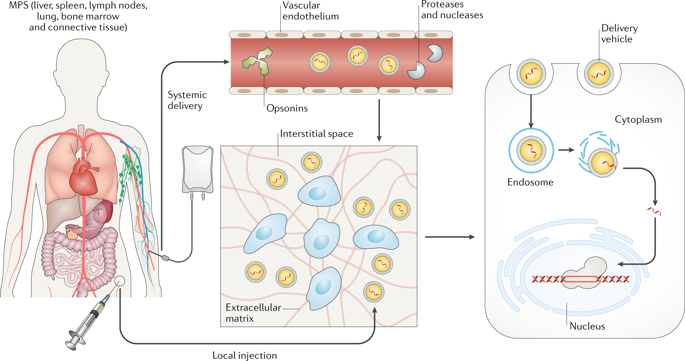Nature Reviews Materials ( IF 83.5 ) Pub Date : 2019-10-04 , DOI: 10.1038/s41578-019-0145-9 Sheng Tong , Buhle Moyo , Ciaran M. Lee , Kam Leong , Gang Bao

|
Genome-editing technologies, such as CRISPR–Cas9, are promising for treating otherwise incurable genetic diseases. Great progress has been made for ex vivo genome editing; however, major bottlenecks exist in the development of efficient, safe and targetable in vivo delivery systems, which are needed for the treatment of many diseases. To achieve high efficacy and safety in therapeutic, in vivo genome editing, editing activities must be controlled spatially and temporally in the body, which requires novel materials, delivery strategies and control mechanisms. Thus, there is currently a tremendous opportunity for the biomaterials research community to develop in vivo delivery systems that overcome the problems of low editing efficiency, off-targeting effect, safety, and cell and tissue specificity. In this Review, we summarize delivery approaches and provide perspectives on the challenges and possible solutions, aiming to stimulate further development of engineered materials for in vivo delivery of genome-editing machinery.
中文翻译:

用于体内传递基因组编辑机器的工程材料
CRISPR–Cas9等基因组编辑技术有望用于治疗其他无法治愈的遗传性疾病。离体基因组编辑已取得重大进展。然而,有效,安全和可靶向的体内递送系统的开发存在主要瓶颈,这是许多疾病的治疗所必需的。为了在治疗性,体内基因组编辑中实现高效和安全,必须在体内在空间和时间上控制编辑活动,这需要新颖的材料,传递策略和控制机制。因此,目前生物材料研究界有巨大的机会来开发体内递送系统,该系统克服了编辑效率低,脱靶效应,安全性以及细胞和组织特异性的问题。在这篇评论中,



























 京公网安备 11010802027423号
京公网安备 11010802027423号